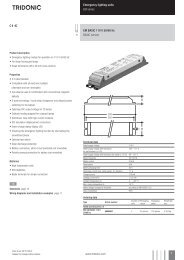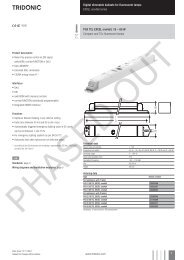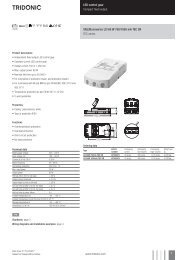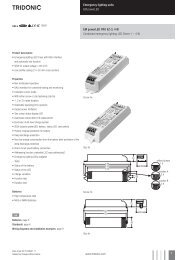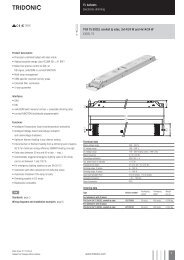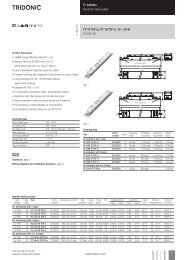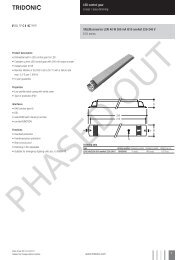You also want an ePaper? Increase the reach of your titles
YUMPU automatically turns print PDFs into web optimized ePapers that Google loves.
.cDesigning a <strong>DALI</strong> applicationDesigning a <strong>DALI</strong> applicationThis section is intended to simplify the planning and configuration of <strong>DALI</strong> installations. Using examples from theApplication Guide it discusses the typical requirements of a <strong>DALI</strong> system and the special features of <strong>Tridonic</strong> products.The following two aspects deserve special attention when designing a <strong>DALI</strong> application.The conceptual aspect: What characteristics must the application have? Should there be daylight-dependentcontrol? Are special lighting scenes or colour applications required? ...The technical aspect: What is possible with <strong>DALI</strong>? What are the limitations of <strong>DALI</strong> and how do these affect theapplication? ...In most cases, the prime consideration will be the conceptual aspect. What are the characteristics of the lightingapplication and what requirements and criteria should they meet? You will then consider the technical aspect andattempt to find the right products to meet these criteria.The technical aspect of the <strong>DALI</strong> installation is closely associated with the planning process.The key to a successful <strong>DALI</strong> installation starts with the installation plan. The installation plan should contain thefollowing points:The position of all the <strong>DALI</strong> devices (including the device type and device name)The grouping of the <strong>DALI</strong> devicesThe <strong>DALI</strong> short address (optional); in some installations it makes sense to define the address at the planningstageThe wiring of the <strong>DALI</strong> circuit including the junction boxes (if there are multiple <strong>DALI</strong> circuits it is best to colourcode them)The cable lengths for each <strong>DALI</strong> circuitConventional wiring or <strong>DALI</strong>If a requirement profile calls for flexible lighting control in which the assignment of the luminaires and control gear canbe changed this must be defined in every detail before the installation phase. For conventional lighting management(without <strong>DALI</strong>) planners have to take into account all the possible lighting control options before work actuallycommences. Conventional planning would provide for multiple control lines per room section to cover all the possibleoptions.With <strong>DALI</strong> all the lighting control options remain open even after the installation is complete and changes are neededto a particular control variant (planning security). There are no additional costs for multiple control lines or rewiringcontrol lines. The decision to opt for <strong>DALI</strong> or a conventional control system depends on the functionality required andthe flexibility with which the lighting system is to be controlled.Design considerationsA number of points deserve special attention when designing a <strong>DALI</strong> application.Maximum of 64 <strong>DALI</strong> devices per <strong>DALI</strong> circuitMaximum of 16 <strong>DALI</strong> groups per <strong>DALI</strong> circuitMaximum of 16 <strong>DALI</strong> scenes per <strong>DALI</strong> circuit<strong>DALI</strong> Manual | 08-2013 | en58 / 93









